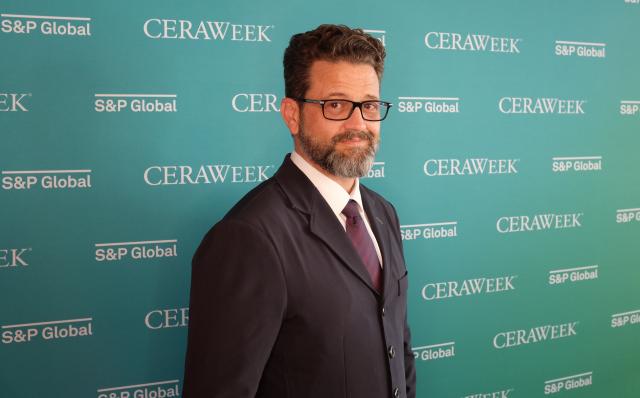
Colin Ward, an oil & gas program fellow with the Riyadh-based King Abdullah Petroleum Studies and Research Center (KAPSARC), during CERAWeek by S&P Global in Houston. (Source: Hart Energy Staff)
The U.S. shale industry will continue in a two-tier system, with one group of companies looking to drill more wells in good times and another taking a more disciplined approach, Colin Ward, an oil & gas fellow at the Saudi-based think tank King Abdullah Petroleum Studies and Research Center (KAPSARC) told Hart Energy during CERAWeek by S&P Global.
“We have the privates who are still doing the old school ‘prices up, [let’s] drill,’ versus the more established large independents…and IOCs [international oil companies] starting to talk about investing the exact same amount every year, whether the market is up or down,” Ward said on March 9 on the sidelines of CERAWeek.
The executive said a mashing of the two approaches would result in about half the growth rate compared to before, but when the market slows it would avoid a crash and production would remain steady.
“So really what you're doing is reducing the volatility of the shale industry,” Ward said.
Ward said unconventional developments would start performing more conventionally with smoother growth rates and declines, as opposed to spiky up-and-downs based on price.
KARSARC estimates the two-tier U.S. shale system will lead a relatively modest outlook for 600,000 bbl/d of crude and condensate supply in 2023 to 700,000 bbl/d in 2024 — half the growth rate of 2019, Ward forecasted in the first quarter of 2023 publication of the KARSARC Oil Market Outlook (KOMO).
KAPSARC supply forecasts and OPEC
The Riyadh-based KAPSARC is an advisory think tank within global energy economics and sustainability, providing services to entities and authorities in the Saudi energy sector.
KAPSARC’s mission aims to advance Saudi Arabia’s energy sector and inform global policies through evidence-based advice and applied research.
KAPSARC’s most recent KOMO, authored by Ward, projects supply growth this year and next.
Global liquids supply is expected to average 102 MMbbl/d in 2023, up 2.68 MMbbl/d, while it is expected to average 104.3 MMbbl/d in 2024.
The forecast is “a fall from approximately 4 MMbbl/d of rebound growth in 2022, with uncertainty around the nexus of Russia, OPEC+, and the G7 offering up-and-downside possibilities,” Ward wrote in the report.
When asked about whether OPEC was again in control of supply, Ward said the “responsibility for being able to try and keep the market on its rails kind of does fall towards them because they're more capable of creating the environment needed to be able to do that because you can always cut [production].”
Ward said OPEC demonstrated that leadership during the pandemic but said the question really came down to whether they could produce more.
“And that’s the spare capacity aspect, as a lot of OPEC members have been talking about underinvestment and the need to do more,” he said, citing Saudi Arabia, the United Arab Emirates, Iraq and Kuwait as examples of countries looking to boost production.
“They have a lot more faith in the viability of oil and gas going forward compared to before 2022… as the talk has moved much more towards energy security,” Ward said.
Recommended Reading
TPG Adds Lebovitz as Head of Infrastructure for Climate Investing Platform
2024-02-07 - TPG Rise Climate was launched in 2021 to make investments across asset classes in climate solutions globally.
Air Products Sees $15B Hydrogen, Energy Transition Project Backlog
2024-02-07 - Pennsylvania-headquartered Air Products has eight hydrogen projects underway and is targeting an IRR of more than 10%.
NGL Growth Leads Enterprise Product Partners to Strong Fourth Quarter
2024-02-02 - Enterprise Product Partners executives are still waiting to receive final federal approval to go ahead with the company’s Sea Port Terminal Project.
Sherrill to Lead HEP’s Low Carbon Solutions Division
2024-02-06 - Richard Sherill will serve as president of Howard Energy Partners’ low carbon solutions division, while also serving on Talos Energy’s board.
Magnolia Appoints David Khani to Board
2024-02-08 - David Khani’s appointment to Magnolia Oil & Gas’ board as an independent director brings the board’s size to eight members.






